Carlisle Borough’s Capital Improvement Program Featured in The Authority
/in Insights-Water & Wastewater /by Judy Lincoln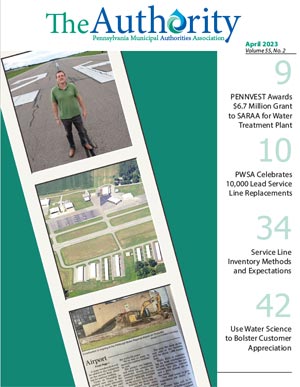 HRG’s water and wastewater practice area leader, Josh Fox, authored an article in the April issue of The Authority with Carlisle Borough’s director of public works, Mark Malarich. They talk about the success the borough has had using infiltration/inflow data to prioritize capital improvement needs and eliminate aging infrastructure. Over the past eight years, the borough has re-lined more than 46,000 linear feet of pipe and repaired, replaced or rehabilitated more than 200 manholes. Josh and Mark also talk about the importance of building flexibility into a capital improvement plan, and the ways they’ve been able to adjust their plans to respond to changing needs.
HRG’s water and wastewater practice area leader, Josh Fox, authored an article in the April issue of The Authority with Carlisle Borough’s director of public works, Mark Malarich. They talk about the success the borough has had using infiltration/inflow data to prioritize capital improvement needs and eliminate aging infrastructure. Over the past eight years, the borough has re-lined more than 46,000 linear feet of pipe and repaired, replaced or rehabilitated more than 200 manholes. Josh and Mark also talk about the importance of building flexibility into a capital improvement plan, and the ways they’ve been able to adjust their plans to respond to changing needs.
Read about Carlisle Borough’s capital improvement plan in The Authority magazine, a publication of the Pennsylvania Municipal Authorities Association
7 Lessons for Pipe Rehabilitation featured in Water & Wastes Digest
/in Insights-Water & Wastewater /by Judy LincolnHRG assistant vice president Ed Ellinger co-authored an article with Capital Region Water’s lead engineer Jeffrey Bowra for the May 2021 issue of Water & Wastes Digest. The article discusses their work together on several phases of water main rehabilitation in the City of Harrisburg and offers 7 tips for maximizing success on pipeline rehabilitation projects. Read it here
Changing Requirements for Water Systems Under the 2020 Lead and Copper Rule Revisions
/in Insights-Water & Wastewater /by Judy LincolnStandard Operating Procedures for Water and Wastewater Facilities
/in Insights-Water & Wastewater /by Judy LincolnEstablishing Smart Fiscal Controls for Municipal Authorities
/in Insights-Financial, Insights-Water & Wastewater /by Judy LincolnMinimizing the Cost of Connecting Homes with On-Lot Disposal Systems to Public Treatment
/in Insights-Water & Wastewater /by Judy LincolnClean water is essential to life, and life is priceless. But sometimes the cost of clean water can be too high for a community to bear. When it is, a mix of grants and forward-thinking design can make the cost more manageable as it did for the residents of a small village in Central Pennsylvania recently.
Kelly Township is a rural municipality in Union County, Pennsylvania, with a population of approximately 5,000 people. The Village of Kelly Crossroads is located in a remote area of the township and consists of 47 homes along Crossroads Drive, SR 1004, and Fort Titzell Road, SR 1003. These homes had historically used on-lot disposal systems for their sewage.
An on-lot disposal system, commonly referred to as a septic system, is a 3-stage treatment process that happens on the site of the home, rather than at a community treatment plant. Sewage collects in a septic tank on-site, where solids and scum are separated from the water via settling and flotation. Pipes then carry the water to the soil where it is absorbed into the ground and purified in nature.
Unfortunately, these systems have a high rate of malfunction, and Kelly Crossroads was no exception. As part of an Act 537 Plan update in 2010, the township confirmed that almost half of the on-lot disposal systems in Kelly Crossroads were malfunctioning. Another 45% exhibited signs of suspected or potential malfunction. Only 6% of the on-lot disposal systems in Kelly Crossroads were functioning properly.
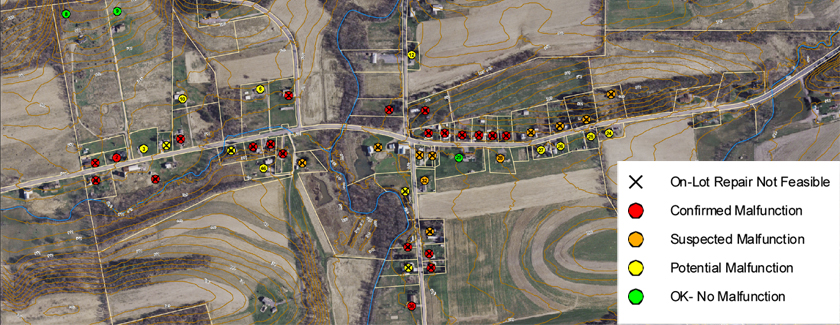
This map shows the location of all the on-lot disposal systems in Kelly Crossroads, and the colors indicate how well each system was functioning. As the map shows, some level of malfunction was widespread throughout the system.
To make matters worse, the township had good reason to believe that these malfunctions were contaminating residents’ water supply. A portion of the homes in Kelly Crossroads relied on wells for their water, and more than half of those wells tested positive for coliform bacteria, an indicator that human waste had come in contact with the water supply.
The township has an obligation to protect the public health, so it needed to address these malfunctioning on-lot disposal systems. Unfortunately, on-site repair was not an option for approximately 70% of the systems. HRG analyzed several alternative approaches and determined that the most cost-effective option was to retire the on-lot disposal systems and replace them with a low-pressure system connected to a package treatment plant.
Cost-effective does not mean low-cost, however. Connecting new homes to a public treatment system is always a costly endeavor, and the cost to connect Kelly Crossroads was estimated at more than $1.6 million. Each homeowner would have to cover the cost of connecting to the system and share in the cost of building the infrastructure it required. This would amount to several thousand dollars in fees per home, a significant burden for an area where the median household income is approximately $55,000.
HRG helped the township obtain nearly $1.5 million in funding from the U.S. Department of Agriculture, Rural Utilities Service, 75% of which was grant money. This funding has dramatically reduced the cost of sewer service to the community.
During initial planning phases of the project, user rates were projected to be as high as $200 per user each month. With the USDA funding, monthly user rates will be $69.
(Learn more about the USDA’s Rural Development Program here.)
HRG designed the system for future expansion of the user base in order to make the project more cost-effective. Capacity is available to connect an additional 5-10 homes if they are constructed adjacent to the system through extension of the LPS system only. Adequate space is also available for future expansion of the treatment plant facilities if more capacity becomes necessary. Planning for future needs now helps to minimize costs down the road.
Construction began in August 2017 and was completed in August 2018. Residents began utilizing the public system in June 2018.
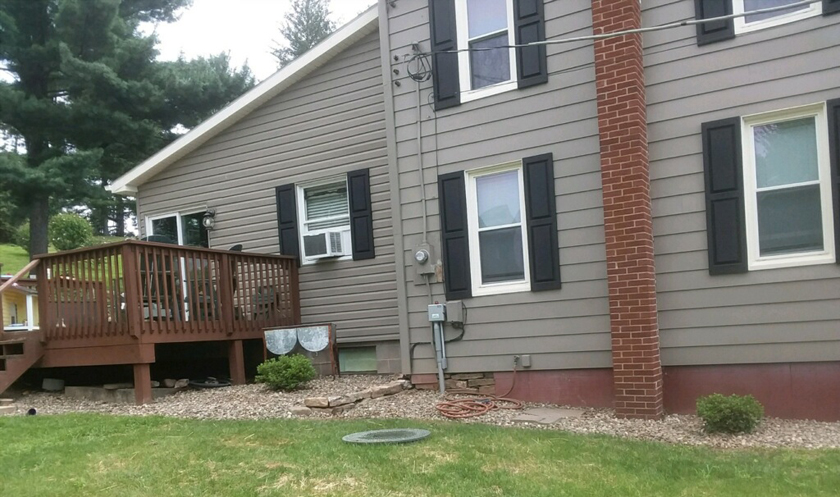
A home in Kelly Crossroads with a recently installed grinder pump
Though the investment is significant, there is no better investment a community (or its residents) can make than in its own health and safety.
Municipalities like Kelly Township want to ensure their residents have clean water, but they are sensitive to how difficult monthly bills can be for residents to pay. They need an engineer who can deliver high quality infrastructure, while helping the community find ways to afford the improvements they need.
A firm with a dedicated team of financial experts can skillfully position the municipality for grants as HRG did for Kelly Township. At the same time, HRG’s water and wastewater professionals designed the system to accommodate future expansion in order to minimize costs moving forward.
Our wastewater treatment professionals are creative problem-solvers, and our financial specialists are experts in water and wastewater financing. We have extensive experience with programs like the USDA’s Rural Development Program, whose support is crucial to ensuring rural communities have quality water and sewer service.
SPECIFICATIONS:
- Low Pressure Collection & Conveyance System w/Homeowner-Owned Grinder Pumps
- 8,200 linear feet of 1.5” – 3” diameter LPS and appurtenances (cleanouts, air release valves, etc.)
- 13,500 GPD Package WWTP consisting of a pre-aeration anoxic activated sludge process and control building
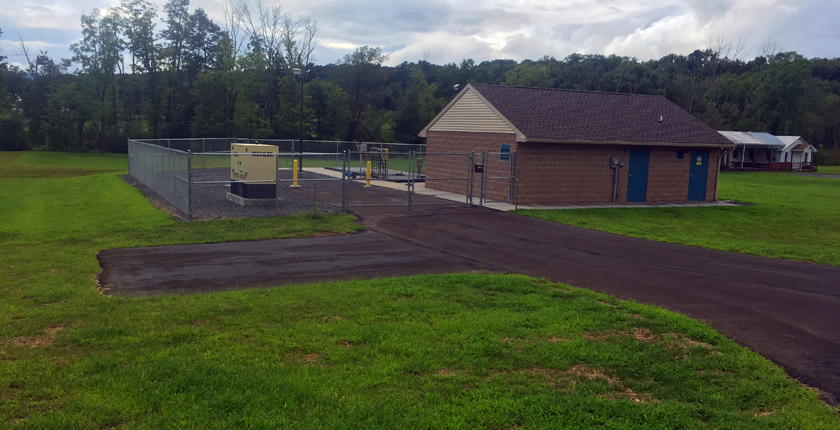
The new 13,500 GPD package wastewater treatment plant serving the Kelly Crossroads community
Polymer Concrete Manholes Offer Longer Life and Less Disruptive Construction Process for Sewer Systems with Different Needs
/in Insights-Water & Wastewater /by Judy LincolnRegularly replacing deteriorated concrete manholes is an expense (and inconvenience) that most sewer systems have learned to live with, but what if they didn’t have to?
We recently incorporated polymer concrete manholes into the design for two of our clients and wanted to share the benefits of this technology with other clients who might be considering manhole repair projects in the near future.
The West Goshen Sewer Authority wanted a long-term structural solution to the hydrogen-sulfide-based Microbial Induced Corrosion (MIC) in its system. We designed 60-inch polymer concrete manholes to replace the severely deteriorated, precast concrete manholes they had on a 30-inch interceptor because polymer concrete is known for its corrosion resistance and 50-year life expectancy.
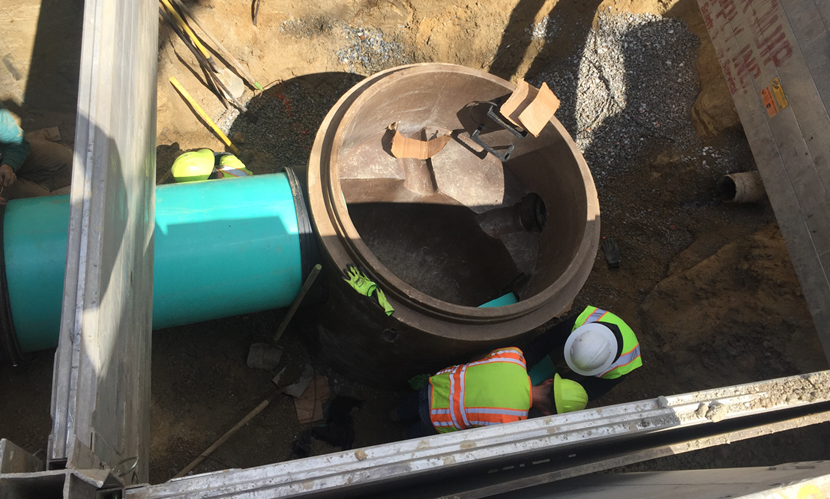
The Lower Swatara Township Municipal Authority wanted to rehabilitate a 48-inch, precast concrete manhole downstream of a force main discharge. Like West Goshen’s manholes, this one was also severely deteriorated due to hydrogen-sulfide-based Microbial Induced Corrosion. Therefore, the corrosion-resistant properties of polymer concrete seemed like a natural solution, but the polymer provided an additional advantage: Its superior strength allows for thinner walls. Lower Swatara’s manhole was located between a state road and a land development project that would be changing the finished grade at the manhole. They needed to rehabilitate the manhole to a new finished grade while minimizing bypass pumping across the state road. The new polymer concrete manhole insert was sized to fit inside the existing manhole, and bypass pumping was unnecessary.

Polymer concrete has existed for several decades, but, for most of that time, it was too expensive for sewer systems to use. Technology has advanced, and the price has come down significantly. Leading edge systems are considering its benefits more and more. Chief among those benefits is corrosion resistance.
Wastewater contains bacteria that naturally produce hydrogen sulfide gas (H2S). This gas leads to Microbial Induced Corrosion (MIC), which eats away at conventional concrete.
To prevent this, sewer systems traditionally use sulfate-resistant Portland cement, which can provide moderate resistance against MIC. In severe situations, sewer systems use concrete additives, coat the concrete, or line it with PVC or HDPE. Polymer concrete provides sewer systems with another option to prevent damage where high levels of H2S-based MIC is present.
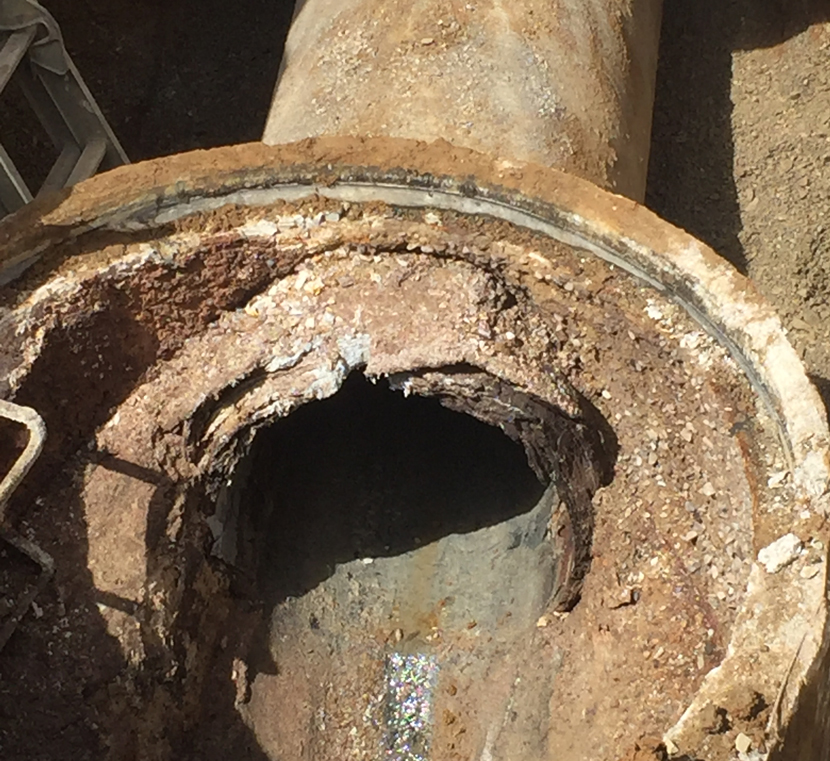
A badly corroded manhole
Many manufacturers produce polymer concrete for sewer system applications. Some use steel reinforcement, while others use fiberglass rebar. Some provide a 50-year warranty for their manholes.
But polymer concrete can be used for more than manholes; it can also be used for pipes and other structures (such as wet wells), too.
An engineer can help you evaluate whether polymer concrete is the right choice for your sewer system and what type will perform best for your particular needs.
Call us to discuss the condition of your sewer system and whether polymer concrete could benefit you.
 Matthew Cichy, P.E., is a senior project manager in HRG’s water and wastewater group. He is an expert in sewer system design, construction, and long-term asset management. His experience includes water distribution systems, wastewater collection and conveyance systems, pumping stations, and water and wastewater treatment plants.
Matthew Cichy, P.E., is a senior project manager in HRG’s water and wastewater group. He is an expert in sewer system design, construction, and long-term asset management. His experience includes water distribution systems, wastewater collection and conveyance systems, pumping stations, and water and wastewater treatment plants.
How One Town Overcame Barriers to Address Aging Infrastructure and Enhance Economic Development
/in Insights-Water & Wastewater /by Judy Lincoln 
This article was published by Pennsylvania Municipal Authorities Association in the August 2017 issue of their magazine, The Authority.
Construction equipment has become a familiar sight to the residents of Middletown Borough in recent years. New businesses are popping up alongside historic buildings in the borough’s downtown business district – thanks, in large part, to a major revitalization effort spearheaded by local government officials.
And it all began by replacing the area’s water and sewer facilities.
The success of Middletown’s revitalization effort illustrates the key role infrastructure plays in building and sustaining great communities. Borough officials and local business leaders wanted to enhance economic development by attracting new businesses to downtown Middletown, but water and sewer problems threatened to kill the success of their efforts before they’d begun. Many communities could’ve seen their dreams derailed by an obstacle like this, but the borough persevered because of strategic planning and the collective effort of a community united behind a common goal. The borough’s story illustrates how communities can overcome barriers and successfully address aging infrastructure in order to enhance economic development.
Aging Infrastructure Presents a Barrier to Development
The Borough of Middletown has the distinction of being the oldest community in Dauphin County. The town was first laid out along the Susquehanna River and Swatara Creek before the Revolutionary War, and brick sewers in the historic downtown area were first installed not long after the Civil War.

Some of Middletown’s water and sewer lines dated back before 1900.
Unfortunately, the sanitary sewer and water facilities located in the downtown business district were not supporting current demand (and they certainly weren’t adequate to meet the demands of new development). The condition of the assets were a risk to the downtown revitalization efforts. In addition, cross-connections between the sanitary sewer system and the storm sewer system led to surcharging and sanitary sewer back-ups.
These challenges made it hard to keep existing businesses downtown and attract new ones. In addition, the borough was planning a streetscape project that would place numerous aesthetic improvements directly above the aging water and sewer facilities. The community did not want to see their investment in these improvements threatened by excavation to repair the sewer and water facilities soon after construction was complete.
Water and Sewer Improvements Lay the Foundation for Future Development
Borough officials asked Herbert, Rowland & Grubic, Inc. to design upgrades to the water and sewer facilities in the heart of its downtown business district (along South Union Street from Spring Street to Ann Street). This project was to be the first phase of its downtown revitalization plan. It included:
- Replacing deteriorated brick sanitary sewer mains with 1,467 feet of new PVC sanitary sewer main
- Eliminating hydraulic “bottle-necking” that restricted sewer flows to the Mill Street Interceptor
- Replacing 7 deteriorated manholes with new precast concrete manholes
- Replacing 44 sewer laterals
- Designing and replacing 2,042 feet of water main
- Replacing 4 hydrants
- Installing 14 valves to isolate future maintenance work as the community continues to upgrade its water infrastructure and to allow for future fire system services to new businesses
HRG began design work in 2013, and construction was complete in 2014. They accelerated the project schedule to reduce stress to the existing local businesses. With the risk of failing water and sewer facilities mitigated, Middletown could begin Phase II of its revitalization effort: improving the streetscape (with new decorative paving, curbing, sidewalks, and street trees) and providing traffic calming devices to promote pedestrian access to the businesses.

New sanitary sewer manhole

New sanitary sewer
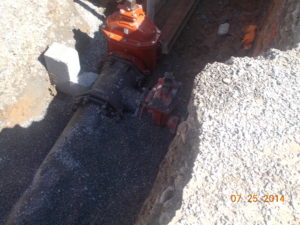
New water main and valves
The Community Comes Together to Make This Project a Success
Efforts to revitalize the downtown business district had generated excitement in the community. Local leaders, business owners, and residents understood that these infrastructure upgrades were vital to attracting new business to the area, and they embraced the investment this project would require.
The former Middletown Borough Authority, the borough, and the Middletown Borough Industrial and Commercial Development Authority led the revitalization effort and engaged the public throughout the process. They held numerous meetings with the public and with local stakeholders to communicate the vision and direction of the project. The project team worked extensively with the owners of local businesses along South Union Street, soliciting their ideas and accommodating special events to minimize disruption to business activity.
Thanks, in part, to these open lines of communication, the project team was able to maintain water and sewer service to the existing businesses in the area throughout the project (despite having a confined working area due to the presence of numerous other utilities).
The engineers also coordinated extensively with other project partners to ensure a smooth transition from Phase I (water and sewer improvements) to Phase II (streetscape enhancements). For example, they coordinated extensively with the streetscape design team to ensure that the water and sewer improvements would not conflict with proposed streetscape facilities, and they worked closely with the landscape architect to ensure that above-ground features like hydrants and manhole covers were installed at locations that would not impact the streetscape visual design concepts. This saved the borough money and ensured that above-ground features would not have to be relocated during Phase II to achieve the aesthetic goals of the streetscape enhancements.
Detailed records about the location and depth of sewer laterals by HRG’s resident project representatives during construction of Phase I provided further cost savings. This information was used for deciding the depth of stormwater facilities in Phase II, reducing design fees in that phase. It also prevented costly change orders that often come from unknown utility locations.
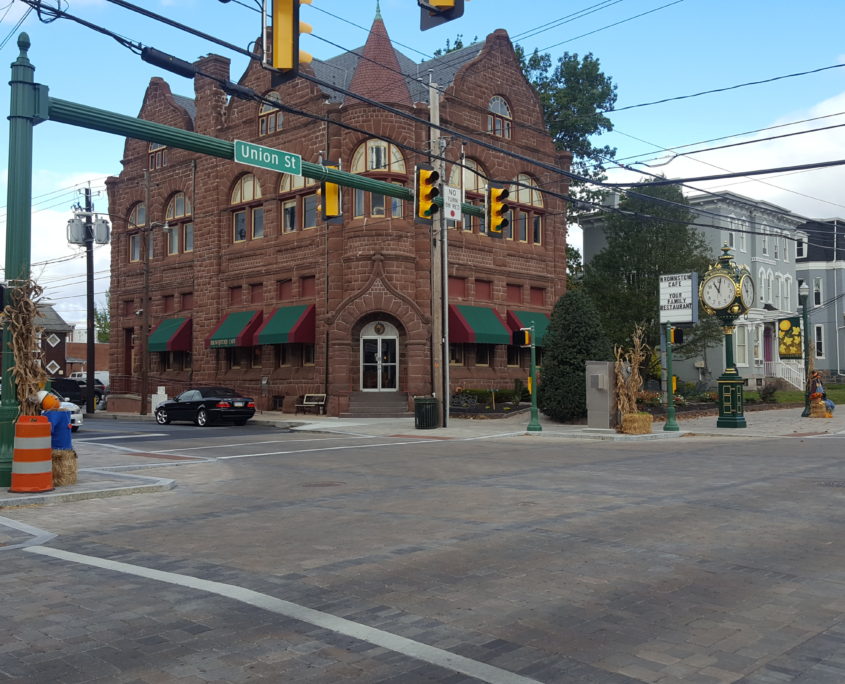
The Improvements Begin to Generate New Development Interest
It didn’t take long for all of this activity to generate interest from developers and business owners in opening new ventures in the area. While the project was in its construction phase, a developer proposed a 100-room hotel with retail space on the first floor just a block away from downtown. The developer also expressed an interest in working with the team behind the streetscape design to develop other projects in the area. He specifically mentioned the downtown revitalization efforts as one of the factors in his decision to invest in the area.
Patrick Devlin of the Tattered Flag Brewery and Still Works also mentioned the flurry of activity downtown as a factor in choosing to locate his business in the old Elks Building. The brewery opened in December 2016 and was recently named the New Business of the Year by the Harrisburg Regional Visitors Bureau.
Business investment like this is expected to continue in Middletown and the surrounding communities. The new sewer infrastructure mitigated a known risk, increased efficiency, and gave the borough additional capacity for the anticipated development.
The water and sewer improvements were completed two weeks ahead of schedule and almost $400,000 under budget. This new infrastructure proved to have a much lower maintenance and operations cost than the aging infrastructure it replaced, and it has drastically reduced infiltration and inflow into the system. During an early phase of design, engineers found and eliminated a cross-connection between the aging sanitary sewer and the borough’s storm sewer system. By eliminating this cross-connection, they were able to prevent approximately 500,000 gallons of stormwater from entering the sewer system during a typical rain event. In fact, since the project was completed, the system has not experienced a single sanitary sewer overflow, and no sewer back-ups have been reported along North Union Street. (You can read more about the correction of this cross-connection here.)
Investing in a project of this magnitude is hard for many communities, but Middletown’s story shows it is possible and the benefits are wide-ranging. When well planned and executed, updated infrastructure lowers maintenance and operations costs, enhances the quality of service to a system’s customers, and helps to attract growth and investment in the community. When citizens and business owners join forces with the local government and think creatively, the seemingly impossible task of upgrading our aging infrastructure while promoting economic development becomes possible!
 Josh Fox, P.E., is the regional manager of water and wastewater services in HRG’s Harrisburg office. He is responsible for the completion of studies, designs, and construction contract administration for a wide variety of water and wastewater treatment facilities. He served as project manager for these water and sewer improvements in Middletown, which were honored by Dauphin County in 2017 with a Premier Project Award.
Josh Fox, P.E., is the regional manager of water and wastewater services in HRG’s Harrisburg office. He is responsible for the completion of studies, designs, and construction contract administration for a wide variety of water and wastewater treatment facilities. He served as project manager for these water and sewer improvements in Middletown, which were honored by Dauphin County in 2017 with a Premier Project Award.
Benefits of Utility Asset Management
/in Insights-Financial, Insights-Local Government, Insights-Municipal, Insights-Water & Wastewater, Uncategorized /by Judy LincolnAs our water systems continue to age past their useful life and utilities face increasing budget pressures, the terms asset management and capital improvement planning have become buzzwords in the industry. However, as utility managers struggle to squeeze as much out of their budgets as possible, it is hard for many of them to justify the additional expense associated with developing and implementing an asset management program. Just like with any other purchase, they want to be sure the benefits outweigh the cost. So what are the benefits of asset management and capital improvement planning?
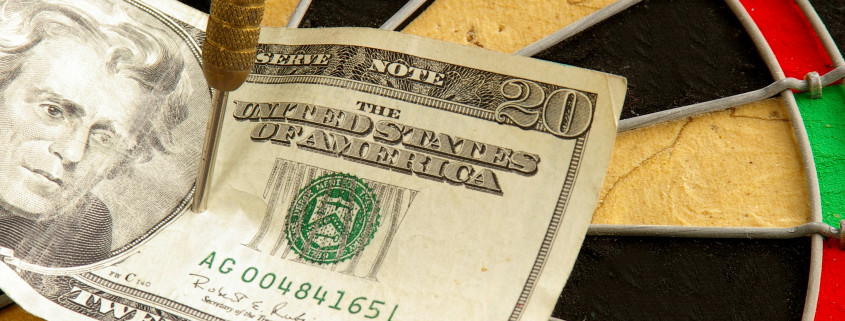
Target budget dollars where they’re needed most and eliminate wasteful spending.
An asset management and capital improvement program helps you identify exactly what maintenance and repair work is necessary without guesswork. Why allocate money toward cleaning out pipes selected at random, when you could target that money to the pipes that need it most (and use the savings to accomplish other system goals)? Why replace pipes simply because of age when they may be in perfectly good condition? Many factors besides age can cause the deterioration of infrastructure.
Photo by TheeErin. Published via a Creative Commons license.
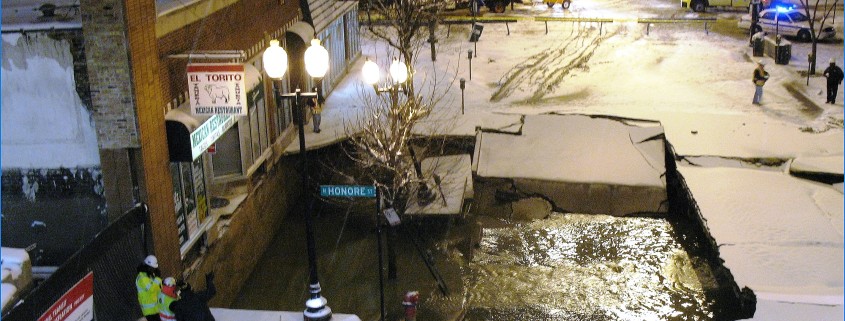
Minimize Risk
Knowing which infrastructure is most likely to fail (and correcting deficiencies before it does) can save you major expenses later in the form of property claims, water loss, etc. Knowing which failures would be the most catastrophic helps you target money toward their prevention as a first priority. With the budget limitations of municipal utility management, you might not be able to prevent every system failure, so it’s important to know which ones have the potential to cause the most financial damage and impact the most customers. This way, you can focus your efforts on preventing those first. If a failure does occur, a good asset management plan will include a proactive response plan, allowing you to respond quicker and more efficiently (thereby reducing damage and disruption).

Maximize Returns
Asset management and capital improvement planning is all about proactively investing in measures to extend the life of your infrastructure. These small investments can extend the life of an asset by several years. Over time, the money you save delaying replacement will far surpass the money you spent to maintain the asset, and your customers will have enjoyed better, more consistent service for this lower cost.

Promote Sustainability
Finding and detecting failures in the system like leaks can prevent water loss and the wasted energy consumed to treat water that never makes it to a customer.

Optimize Customer Service and Satisfaction
Proactively maintaining your assets ensures they function at peak performance for a longer period of time and are replaced before they fail. This means your customers receive top quality service without disruption and are happier for it. In addition, many asset management solutions include optional customer service applications that make it easier for customers to submit service requests and track them to completion.
Justify Your Rates
Rate increases are never popular with customers, but they are easier for them to accept when they are backed up with clear data showing exactly what improvements are needed and why.

Access grants and loans
Competition for funding is fierce, and government agencies are under pressure to make sure the money they invest is used wisely. As a result, they’re more likely to award funds to utilities who have clear documentation of the project need, its benefits, and a plan for getting it built, operating it, and maintaining it at optimum levels over time.
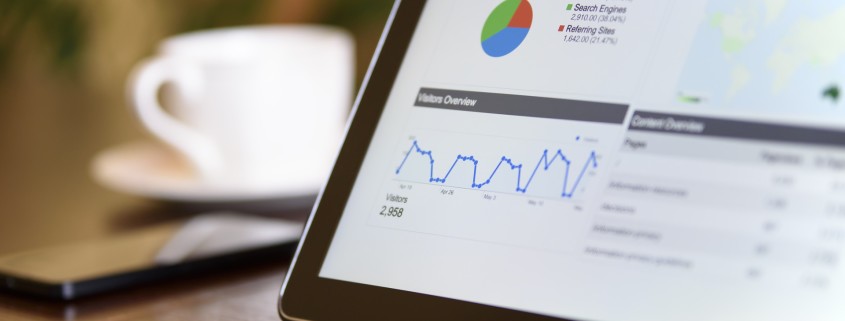
Know your worth
Many utilities have been considering the option of leasing or selling their assets as a response to growing financial obligations in the public sector. A comprehensive asset management system provides documentation of the value of your assets, so you can ensure you are in a position to negotiate the best possible deal for you and your customers. Potential investors will be more comfortable making a significant investment if they fully understand the value and the risks they’re assuming. (For more Insight into the utility leasing trend, see our article on calculating fair annual rental value.)
Every manager must take careful stock of his revenue and his expenses, but not all expenses are created alike. There is a difference between a cost and an investment, and asset management is clearly an investment in your utility’s future. In essence, it helps you provide better service at a lower cost with reduced risk and improved financing options. How many investments can you make that provide that kind of return?

